Derby's Heritage Part 30 - Back To The Market Place
w/e 24 June 2012
All this week's pictures were taken
with a Kodak DX6490
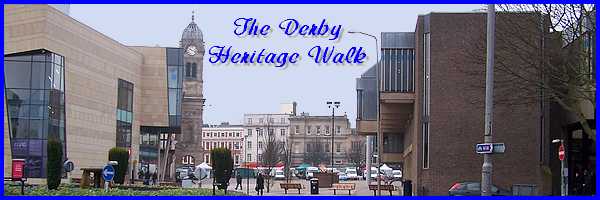
Our walk around Derby looking at the heritage of
the city began at the Tourist Information Centre in the Market
Place over two years ago in January 2010. Our initial foray took
us north from the city centre to the Chester Green area but we
passed through the Market Place again in the middle of 2011 on
our way south to the Arboretum. Now in this 30th part of the
walk we return once again to the Market Place.
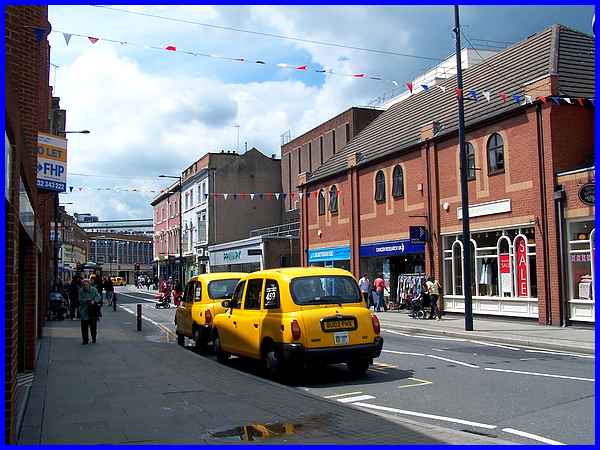
We resume our walk at the end of Exchange Street where it meets
Albert Street, which as we discovered earlier in the walk was
pitched along the line of the Markeaton Brook in 1848. A continuation
of Victoria Street from St Peter's Bridge, it was named after
HRH Prince Albert, Prince Consort (1819-1861) to Queen Victoria
who had acceded to the throne in 1837. The area had originally
been named Old Cotton Mill Yard having been in existence since
1819.
|
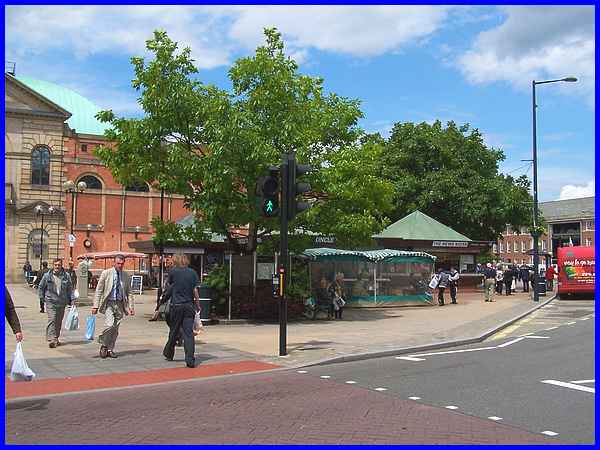
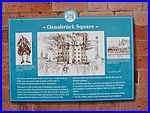 Across
and to the right from Exchange Street is Osnabrück Square
where an information board (left) on the wall of the Market Hall
tells a little more about the Cotton Mill which gave rise to
the original name of the area. The land to the north of Markeaton
Brook had been purchased by the cotton pioneer Jedidiah Strutt
and a six storey "fireproof" calico mill designed by
his son William utilising cast iron with Baltic fir beams encased
in Roman cement, was built here in 1793. The board continues:
"In 1876 the mill was, ironically, Across
and to the right from Exchange Street is Osnabrück Square
where an information board (left) on the wall of the Market Hall
tells a little more about the Cotton Mill which gave rise to
the original name of the area. The land to the north of Markeaton
Brook had been purchased by the cotton pioneer Jedidiah Strutt
and a six storey "fireproof" calico mill designed by
his son William utilising cast iron with Baltic fir beams encased
in Roman cement, was built here in 1793. The board continues:
"In 1876 the mill was, ironically,  damaged by its second fire.
It was then sold to the Corporation in February 1877 and demolished
to extend the Market Hall and widen Albert Street." damaged by its second fire.
It was then sold to the Corporation in February 1877 and demolished
to extend the Market Hall and widen Albert Street."
Between the 1920s and 1980s the area was occupied by the Fish
Market but it was then landscaped and renamed Osnabrück
Square in 1986 after Derby's twin city in Germany. The original
partnership treaty between the two cities had been signed on
17 February 1976. A monument presented by the people of Osnabrück
features several inscriptions the one pictured (right) displaying
the distance between the two being 800 kilometres or 500 miles.
|
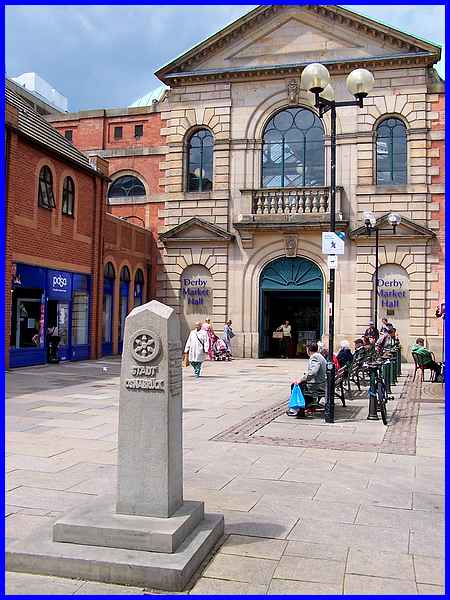
Passing through Osnabrück Square and by the monument our
route now takes us into the Market Hall constructed to a design
by Melbourne engineer Rowland Mason Ordish at a cost of £29000
and opened in 1866.
|
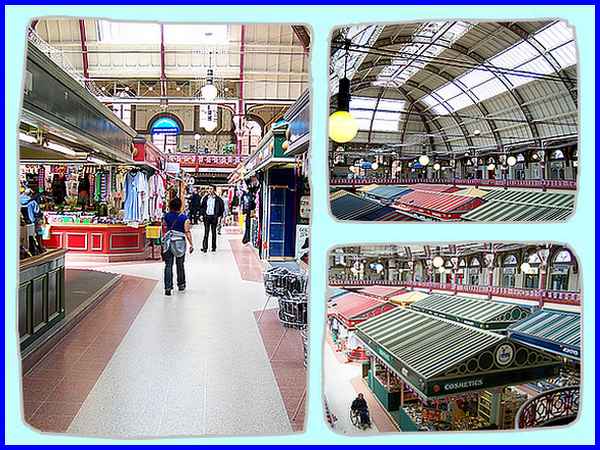
Justifiably recognised as a "Victorian architectural masterpiece"
the hall is now Grade II listed and is notable for its tunnel
vaulted roof of iron and glass, supported by iron columns. The
ironwork was made in Derby by J. and G. Haywood's Phoenix Foundry.
The hall was designed by Borough Surveyor Robert Thorburn and
after structural weaknesses were observed, the design modified
by Thorburn's sucessor Edwin Thompson. The foundation stone was
laid on February 16th 1864 by the Mayor of Derby, Thomas Roe
Esq. Featuring market stalls at ground level with more traders
operating from the balcony above, the hall was restored in 1989
and reopened by HRH the Princess Margaret in the November of
that year.
|
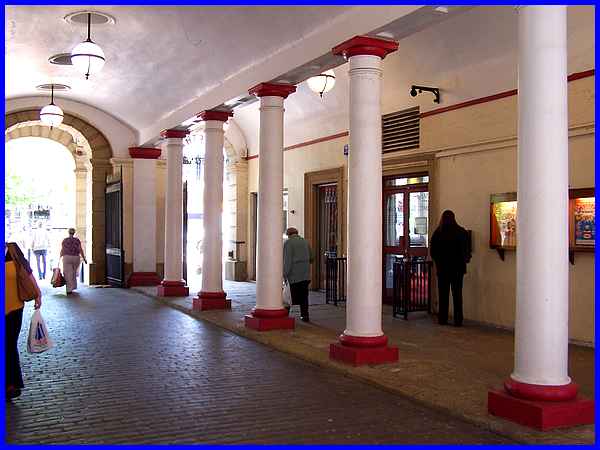
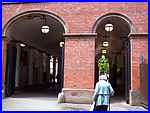 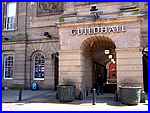 There are several
ways into and out of the Market Hall including one to Lock-up
Yard and the Fish Market that we saw in Part 18 of this walk
but by walking straight through the hall from Osnabrück
Square we can leave via another small yard (left) and through
this passage past the Guildhall Theatre (above) to reach the
Market Square again in front of the Guildhall (right). There are several
ways into and out of the Market Hall including one to Lock-up
Yard and the Fish Market that we saw in Part 18 of this walk
but by walking straight through the hall from Osnabrück
Square we can leave via another small yard (left) and through
this passage past the Guildhall Theatre (above) to reach the
Market Square again in front of the Guildhall (right).
|
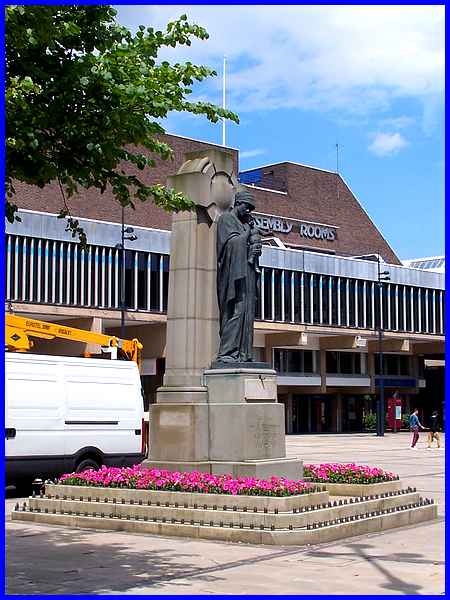
On leaving the passage under the Guildhall the most obvious feature
apart from the Assembly Rooms opposite is the Derby War Memorial.
Sculptured by George Arthur Walker in 1924 it initially honoured
the fallen of the First World War but subsequently has had additional
inscriptions added for the Second and other later conflicts.
The bronze figures on the memorial are of the Virgin Mary and
the baby Jesus.
|
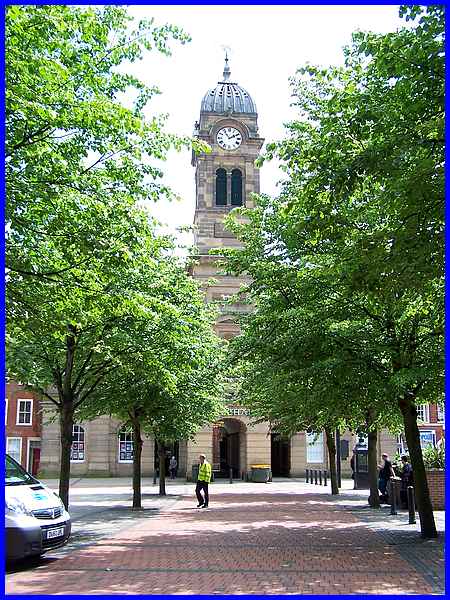
An avenue of trees leads directly from the front of the Guildhall
across the Market Place and it is here once a month that a Farmers'
Market is held. It is worth walking across the Market Place to
turn and survey the magnificent 103 foot high clock tower designed
by local Derby man, Henry Duesbury that has stood here since
1842 after the original Guildhall was destroyed by fire a year
earlier.
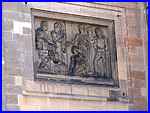 Duesbury
also incorporated into his design either side of the tower, stone
bas-reliefs (left) by John Bell of London (1812-1896) representing
judicial and municipal proceedings. The existing Guildhall was
built on the remains of the fire damaged structure of 1828 by
architect Matthew Habershon but a Guildhall has stood on or near
this site since at least 1530. Originally used as a meeting place
for trades guilds it also served as the Town Hall and council
chambers and Assize Courts were also held in the building twice-yearly
but today its primary function is that of the small and intimate
Guildhall Theatre. Duesbury
also incorporated into his design either side of the tower, stone
bas-reliefs (left) by John Bell of London (1812-1896) representing
judicial and municipal proceedings. The existing Guildhall was
built on the remains of the fire damaged structure of 1828 by
architect Matthew Habershon but a Guildhall has stood on or near
this site since at least 1530. Originally used as a meeting place
for trades guilds it also served as the Town Hall and council
chambers and Assize Courts were also held in the building twice-yearly
but today its primary function is that of the small and intimate
Guildhall Theatre.
|
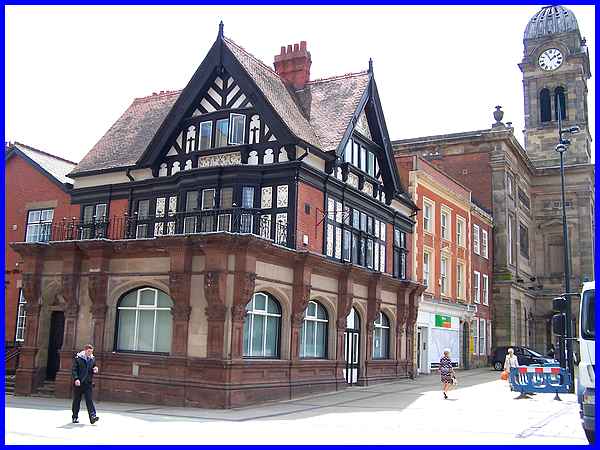
 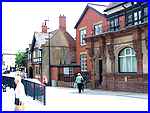 Another old building near to the Guildhall
was also destroyed by fire, this time in the 1880s. That was
an inn that had first been recorded on the site in 1732. The
new building of 1889/90 and called the Royal Oak closed as a
pub in 1916 and became offices for a variety of users over the
years. It has been put into service as the Mayor's Parlour, the
Town Clerk's office and has also been used by solicitors. Refurbished
in 2004 Royal Oak House is now Derby's Register Office. Another old building near to the Guildhall
was also destroyed by fire, this time in the 1880s. That was
an inn that had first been recorded on the site in 1732. The
new building of 1889/90 and called the Royal Oak closed as a
pub in 1916 and became offices for a variety of users over the
years. It has been put into service as the Mayor's Parlour, the
Town Clerk's office and has also been used by solicitors. Refurbished
in 2004 Royal Oak House is now Derby's Register Office.
In the next part we will leave the Market Square again and see
some of Derby's heritage of the future if that's not a contradiction
of terms.
|

